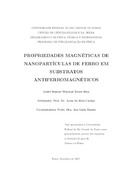Use este identificador para citar ou linkar para este item:
https://repositorio.ufrn.br/handle/123456789/16529| Título: | Propriedades magnéticas de nanopartículas de ferro em substratos antiferromagnéticos |
| Autor(es): | Silva, André Stuwart Wayland Torres |
| Orientador: | Carriço, Artur da Silva |
| Palavras-chave: | Nanopartículas;Substratos AF;Exchange bias;Coercividade;Nanoparticles;Substrates AF;Exchange bias;Coercivity |
| Data do documento: | 7-Dez-2007 |
| Editor: | Universidade Federal do Rio Grande do Norte |
| Referência: | SILVA, André Stuwart Wayland Torres. Propriedades magnéticas de nanopartículas de ferro em substratos antiferromagnéticos. 2007. 165 f. Tese (Doutorado em Física da Matéria Condensada; Astrofísica e Cosmologia; Física da Ionosfera) - Universidade Federal do Rio Grande do Norte, Natal, 2007. |
| Resumo: | O efeito de tamanho finito nas propriedades magnéticas de sistemas de partículas ferromagnéticos é um tema recorrente. Um dos aspectos largamente investigados é o limite superparamagnético em que a temperatura desestabiliza a ordem magnética de partículas ferromagnéticas pequenas. Acima da temperatura de bloqueio o valor médio térmico do momento magnético da partícula se torna nulo, devido a flutuações térmicas. A temperatura de bloqueio diminui quando o tamanho da partícula é reduzido, refletindo a queda na barreira de energia de anisotropia entre os estados de magnetização uniforme ao longo do eixo uniaxial. A demanda crescente por meios de gravação magnética de alta densidade tem atualmente despertado grande interesse de pesquisa em arranjos periódicos de partículas ferromagnéticas de dimensões nanométricas, beirando o limite superparamagnético. Uma conjectura interessante, levantada experimentalmente, se refere à possibilidade de estabilização da ordem magnética de partículas ferromagnéticos (F) via o acoplamento de interface com substratos antiferromagnéticos (AF) com temperatura de Nèel acima da temperatura ambiente. Esses sistemas se prestam igualmente para elucidar alguns detalhes do efeito de Exchange bias , dado que, o efeito de rugosidade de interface e o papel de paredes de domínio, seja no substrato ou na partícula, são reduzidos. Investigamos as fases magnéticas de uma pequena partícula ferromagnética, com diversas geometrias e disposições de deposição sobre um substrato antiferromagnético. Usamos um método de campo local auto-consistente, incorporando o campo de interface e a interação dipolar entre os spins da partícula ferromagnética. Nossos resultados indicam que aumentando a área da interface favorece a formação do estado uniforme. Porém se a altura da partícula é superior a um valor crítico surge um estado não-uniforme em que os spins se orientam de modo a minimizar a carga magnética superficial. Discutimos o impacto que a competição entre esses efeitos tem na carga magnética líquida, que controla o campo de fuga da partícula e no formato das curvas de histerese. Nossos resultados indicam que a carga líquida não é uma função monotônicamente crescente da altura da partícula e que o deslocamento da histerese pode sofrer alterações relevantes, induzidas pelo campo dipolar, fugindo do padrão esperado normalmente em sistemas F/AF extensos |
| Abstract: | The effect of finite size on the magnetic properties of ferromagnetic particles systems is a recurrent subject. One of the aspects wide investigated is the superparamagnetic limit where the temperature destroys the magnetic order of ferromagnetic small particles. Above the block temperature the thermal value of the magnetic moment of the particle vanishes, due to thermal fluctuations. The value of the blocking temperature diminishes when the size of the particle is reduced, reflecting the reduction of the anisotropy energy barrier between the uniform states along the uniaxial axis. The increasing demand for high density magnetic media has recently attracted great research interest in periodic arrangements of nanometric ferromagnetics particles, approach in the superparamagnetic limit. An interesting conjecture is the possibility of stabilization of the magnetic order of small ferromagnetic particles (F) by interface coupling with antiferromagnetic (AF) substrate. These F/AF systems may also help to elucidate some details of the effect of exchange bias, because the effect of interface roughness and the paper of domain walls, either in the substrate or the particle, are significantly reduced. We investigate the magnetic phases of small ferromagnetic particles on a antiferromagnetic substrate. We use a self-consistent local field method, incorporating the interface field and the dipole interaction between the spins of the ferromagnetic particle. Our results indicate that increasing the area of the interface favors the formation of the uniform state. Howere above a critical height value appears a state non-uniform is formed where the spins of in the particle s free surface are rotated with respect to the interface spins direction. We discuss the impact of the competition between the dipolar and interface field on the magnetic charge, that controls the field of flux leakage of the particle, and on the format of the hysteresis curves. Our results indicate that the liquid magnetic charge is not a monotonically increasing function of the height of the particle. The exchange bias may display anomalous features, induced for the dipolar field of the spins near the F/AF interface |
| URI: | https://repositorio.ufrn.br/jspui/handle/123456789/16529 |
| Aparece nas coleções: | PPGFIS - Doutorado em Física |
Arquivos associados a este item:
| Arquivo | Descrição | Tamanho | Formato | |
|---|---|---|---|---|
| AndreSWTS_TESE.pdf | 8,5 MB | Adobe PDF |  Visualizar/Abrir |
Os itens no repositório estão protegidos por copyright, com todos os direitos reservados, salvo quando é indicado o contrário.

